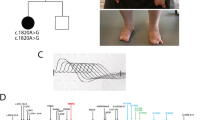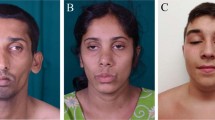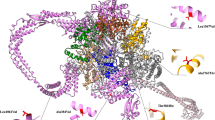Abstract
Megaconial congenital muscular dystrophy (CMD)(OMIM #602541), related to CHKB mutation, is a rare autosomal recessive disorder. To date, only 35 confirmed patients are recorded. We present a detailed description of the clinical, histopathological, imaging, and genetic findings of five children from four Indian families. The children had moderate-to-severe autistic behavior, hand stereotypies, and global developmental delay mimicking atypical Rett syndrome. In addition, generalized hypotonia was a common initial finding. The progression of muscle weakness was variable, with two patients having a milder phenotype and three having a severe form. Interestingly, the majority did not attain sphincter control. Only patient 1 had classical ichthyotic skin changes. Muscle biopsy in two patients showed a myopathic pattern with characteristic peripherally placed enlarged mitochondria on modified Gomori trichrome stain and electron microscopy. Genetic analysis in these patients identified three novel null mutations in CHKB [c.1027dupA (p.Ser343LysfsTer86);c.224 + 1G > T (5′ splice site); c.1123C > T (p.Gln375Ter)] and one reported missense mutation, c.581G > A (p.Arg194Gln), all in the homozygous state. Megaconial CMD, although rare, forms an important group with a complex phenotypic presentation and accounted for 5.5% of our genetically confirmed CMD patients. Atypical Rett syndrome-like presentation may be a clue towards CHKB-related disorder.
This is a preview of subscription content, access via your institution
Access options
Subscribe to this journal
Receive 12 print issues and online access
$259.00 per year
only $21.58 per issue
Buy this article
- Purchase on Springer Link
- Instant access to full article PDF
Prices may be subject to local taxes which are calculated during checkout





Similar content being viewed by others
Change history
26 March 2021
A Correction to this paper has been published: https://doi.org/10.1038/s10038-021-00920-2
References
Aoyama C, Liao H, Ishidate K. Structure and function of choline kinase isoforms in mammalian cells. Prog Lipid Res. 2004;43:266–81.
Mitsuhashi S, Hatakeyama H, Karahashi M, Koumura T, Nonaka I, Hayashi YK, et al. Muscle choline kinase beta defect causes mitochondrial dysfunction and increased mitophagy. Hum Mol Genet. 2011;20:3841–51.
Nishino I, Kobayashi O, Goto Y, Kurihara M, Kumagai K, Fujita T, et al. A new congenital muscular dystrophy with mitochondrial structural abnormalities. Muscle Nerve [Internet]. 1998;21:40–7.
Sher RB, Aoyama C, Huebsch KA, Ji S, Kerner J, Yang Y, et al. A rostrocaudal muscular dystrophy caused by a defect in choline kinase beta, the first enzyme in phosphatidylcholine biosynthesis. J Biol Chem. 2006;281:4938–48.
Mitsuhashi S, Ohkuma A, Talim B, Karahashi M, Koumura T, Aoyama C, et al. A congenital muscular dystrophy with mitochondrial structural abnormalities caused by defective de novo phosphatidylcholine biosynthesis. Am J Hum Genet. 2011;88:845–51.
McLaren W, Pritchard B, Rios D, Chen Y, Flicek P, Cunningham F. Deriving the consequences of genomic variants with the Ensembl API and SNP effect predictor. Bioinformatics 2010;26:2069–70.
DiMauro S, Schon EA, Carelli V, Hirano M. The clinical maze of mitochondrial neurology. Nat Rev Neurol. 2013;9:429–44.
De Goede C, Oh T, Joseph J, Muntoni F, Sewry C, Phadke R. Choline kinase beta-related muscular dystrophy, appearance of muscle involvement on magnetic resonance imagpedigree diagrams of the families under studying. Pediatr Neurol. 2016;54:49–54.
Chan SH, Ho RS, Khong PL, Chung BH, Tsang MH, Yu MH, et al. Megaconial congenital muscular dystrophy: same novel homozygous mutation in CHKB gene in two unrelated Chinese patients. Neuromuscul Disord. 2020;30:47–53.
Quinlivan R, Mitsuahashi S, Sewry C, Cirak S, Aoyama C, Mooore D, et al. Muscular dystrophy with large mitochondria associated with mutations in the CHKB gene in three British patients: extending the clinical and pathological phenotype. Neuromuscul Disord. 2013;23:549–56.
Gutiérrez Ríos P, Kalra AA, Wilson JD, Tanji K, Akman HO, Area Gómez E, et al. Congenital megaconial myopathy due to a novel defect in the choline kinase beta gene. Arch Neurol. 2012;69:657–61.
Marchet S, Invernizzi F, Blasevich F, Bruno V, Dusi S, Venco P, et al. Alteration of mitochondrial membrane inner potential in three Italian patients with megaconial congenital muscular dystrophy carrying new mutations in CHKB gene. Mitochondrion 2019;47:24–9.
Castro-Gago M, Dacruz-Alvarez D, Pintos-Martínez E, Beiras-Iglesias A, Delmiro A, Arenas J, et al. Exome sequencing identifies a CHKB mutation in spanish patient with megaconial congenital muscular dystrophy and mtDNA depletion. Eur J Paediatr Neurol. 2014;18:796–800.
Mitsuhashi S, Nishino I. Megaconial congenital muscular dystrophy due to loss-of-function mutations in choline kinase β. Curr Opin Neurol. 2013;26:536–43.
Overall ADJ, Nichols RA. A method for distinguishing consanguinity and population substructure using multilocus genotype data. Mol Biol Evol. 2001;18:2048–56.
Desmet FO, Hamroun D, Lalande M, Collod-Bëroud G, Claustres M, Béroud C. Human Splicing Finder: an online bioinformatics tool to predict splicing signals. Nucleic Acids Res. 2009;37:1–14.
Ehrhart F, Coort SLM, Cirillo E, Smeets E, Evelo CT, Curfs L. New insights in Rett syndrome using pathway analysis for transcriptomics data. Wien Medizinische Wochenschr. 2016;166:346–52.
Acknowledgements
We thank the patients and their families in this study.
Author information
Authors and Affiliations
Corresponding author
Ethics declarations
Conflict of interest
The authors declare no competing interest.
Additional information
Publisher’s note Springer Nature remains neutral with regard to jurisdictional claims in published maps and institutional affiliations.
Rights and permissions
About this article
Cite this article
Bardhan, M., Polavarapu, K., Bevinahalli, N.N. et al. Megaconial congenital muscular dystrophy secondary to novel CHKB mutations resemble atypical Rett syndrome. J Hum Genet 66, 813–823 (2021). https://doi.org/10.1038/s10038-021-00913-1
Received:
Revised:
Accepted:
Published:
Issue Date:
DOI: https://doi.org/10.1038/s10038-021-00913-1



